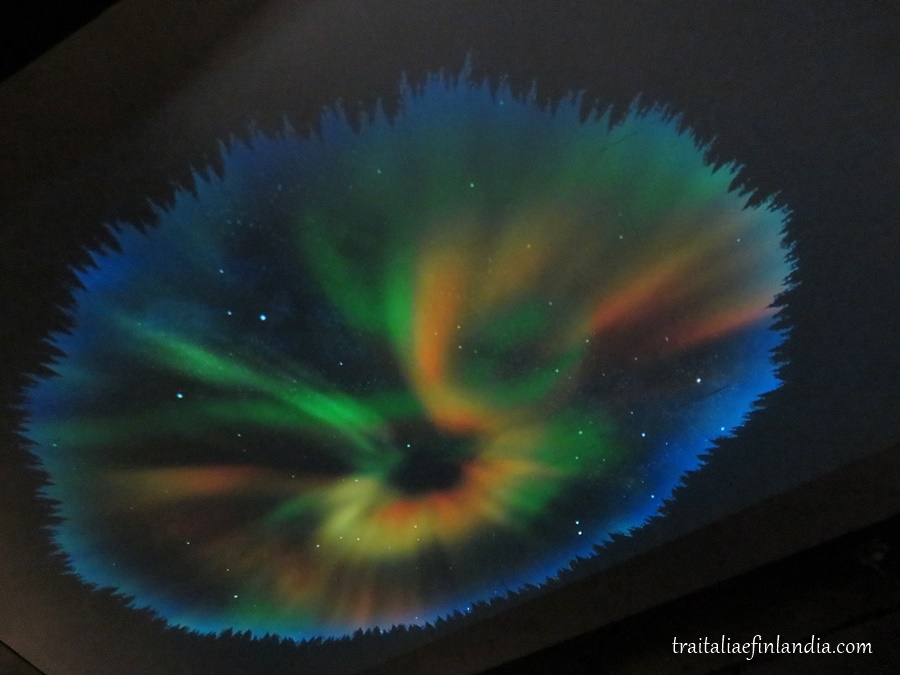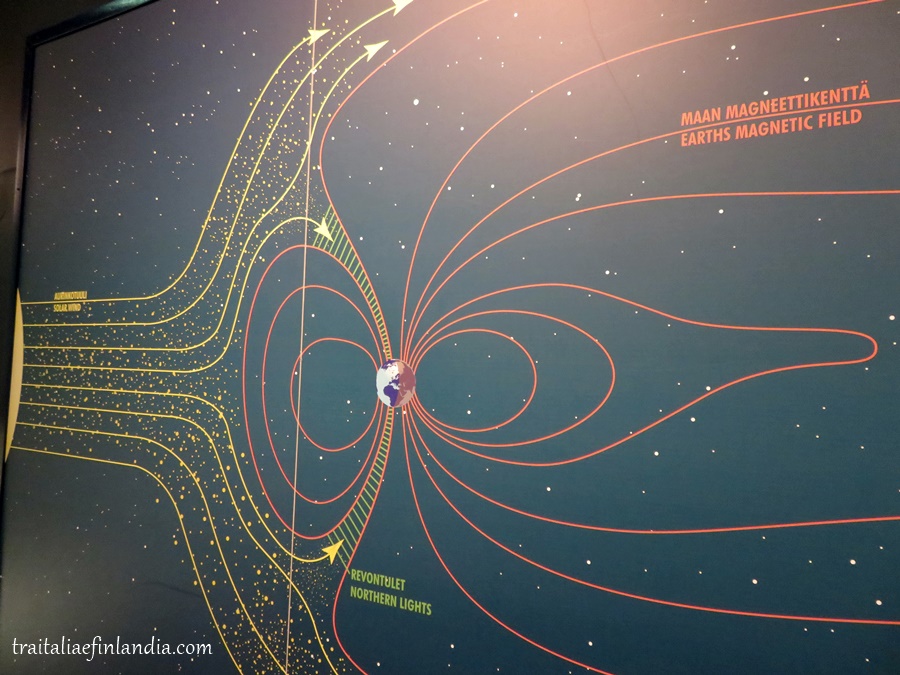*please scroll down for English version*

Nel museo Arktikum, in centro a Rovaniemi, abbiamo assistito ad una bellissima ricostruzione audiovisiva del fenomeno Aurora boreale dal doppio punto di vista della scienza e della laggenda.
Prima di tutto parliamo di scienza: il fenomeno e’ dovuto, come oggi sappiamo tutti, a picchi di attivita’ solare che si scontrano col campo magnetico terrestre. I diversi colori sono dovuti all’accelerazione degli atomi di ossigeno (giallo, verde e rosso) e azoto (blu e viola). Lo spettacolo inizia solitamente con archi di luce che si muovono in direzione est-ovest, seguendo il magnetismo terrestre, per poi portarsi in alto verso lo zenit.
Secondo le statistiche, nell’estremo nord Finlandia l’aurora boreale e’ visibile tre notti su quattro; man mano che si scende verso sud l’intensita’ del fenomeno va scemando ed e’ sempre meno visibile. Deve essere veramente potente per essere visibile nel sud Finlandia. Nella regione polare altresi’ vi e’ pochissima attivita’, per cui il fenomeno e’ raramente visibile, un po’ come l’occhio del ciclone.

Naturalmente questo spettacolo grandioso ed impressionante ha da sempre destato la curiosita’ dei nostri antenati, che si sono dati varie spiegazioni, creando numerose leggende. Ve ne racconto alcune – sempre trovate al museo Arktikum: gli antichi Romani associavano l’Aurora boreale ad una pioggia di sangue, presumibilmente perche’ visto da sud il fenomeno si presenta un po’ piu’ rosso e meno verde-giallo.
Nel nord della Cina la si pensava essere il risultato dello scontro fra un dragone o un serpente e alcune milizie celesti.
Per i nativi Americani spesso presagiva guerre o disastri.
La tradizione del popolo Sami rappresenta l’aurora come una serie di esseri celesti che parlano fra loro; di conseguenza quando la si scorge bisogna guardarla in silenzio, per non venire rapiti da quegli esseri.
Infine la leggenda che tuttora da’ il nome all’Aurora boreale in lingua finlandese: REVONTULET, cioe’: i fuochi della volpe. La leggenda dice che i colori nel cielo sono generati da una volpe celeste che corre a gran velocita’ provocando scintille.
Nel video seguente la ricostruzione e’ perfetta: buona visione e grazie al Museo Arktikum!
The Fires of the Fox.
In the Arktikum Museum in Rovaniemi we had the possibility to watch a modern audio-visual explaining how Northern Lights happen. Actually, it was half-way between science and fantasy.
Let’s talk about science first: as we know nowadays, Northern Lights are the result of of disturbances in the Earth magnetosphere caused by solar wind. The main colours of the phenomenon are greenish-yellow, red and purple-blue. The greenish-yellow and red are created by the excitation of oxygen, the blue-purple originate from nitrogen. The light show starts with greenish-yellow arcs going in an east-west direction: the direction of the lines of force of the Earth magnetic field. At the same time the solid coloured area sets into vertical rays and moves up to the zenith.
According to statistics, three nights out of four the Northern Lights are visible in very north Finland. The further south one goes, the frequence of the Northern Lights drops sharply. Also in the centre of the Aurora oval, in the polar regions, there is less activity. The phenomenon must be quite powerful to be seen in southern Finland.
This magnificent spectacle has understandably made our ancestors wonder for centuries. Man has tried to explain it and has invented several legends. I will share a few I collected in the museum: the Ancient Romans described it as a bloody rain, maybe because seen from south the red colour is prevalent.
In north China people saw it as a fight of some dragon or snake against heavenly troops.
American Natives thought it predicted wars and disasters.
Traditional Sami beliefs consider Auroras to be celestial living beings who talk, therefore you must watch it silently not to be taken awayd by them.
Finally, the strongest legend, the one which names the Aurora in Finnish language: REVONTULET, that is: the Fires of the Fox. It is said to be a celestial fox running fast and generating sparks.
In the excellent video above, you will get to know it better, hope you enjoy it! Thanks to the Arktikum Museum.
****
.
Linked to: Skywatch Friday. Friday Bliss. Jaipur Garden. All Seasons. WATW My Corner of the World.

Bellissimo!
"Mi piace"Piace a 1 persona
Grazie! 🙂
"Mi piace""Mi piace"
Wow! Gorgeous!
"Mi piace"Piace a 1 persona
Thank you!
"Mi piace""Mi piace"
Wow! So beautiful.
"Mi piace""Mi piace"
Thank you very much!
"Mi piace""Mi piace"
Hello,
Beautiful images and what a lovely exhibit. I was able to see the Northern Lights in Iceland, it is an amazing sight to see. Take care, enjoy your day! Happy weekend!
"Mi piace"Piace a 1 persona
Avevo già incontrato la parola REVONTULET ma non avevo capito il significato… bellissimo, grazie!
"Mi piace"Piace a 1 persona
…I have only seen pictures of the Aurora Borealis, this is something that I’d love to see in person!
"Mi piace"Piace a 1 persona
So interesting! I have never managed to see Aurora borealis live, but I have not travelled to the North many times. You had a wonderful experience ! Have a lovely weekend.
"Mi piace"Piace a 1 persona
Bellissimo, interessante post.
"Mi piace"Piace a 1 persona
spettacolo! adoro l’aurora, ho avuto la fortuna di vederla in islanda e mi e’ rimasta nel cuore!
"Mi piace"Piace a 1 persona
Wow, quanto mi piacerebbe vederli! ❤️
"Mi piace"Piace a 1 persona
I have seen them from time to time in my part of the world. They have to be very strong, however, to show up under the city lights.
"Mi piace"Piace a 1 persona
straordinarie queste immagini!! La bellezza della natura nelle sue forme più belle!!! 😉
"Mi piace"Piace a 1 persona
Northern Lights are so beautiful. Thanks for the information. Very interesting!
"Mi piace"Piace a 1 persona
Wow
"Mi piace"Piace a 1 persona
Thank you very much, Peter. Have a good day!
"Mi piace""Mi piace"
Quante se ne imparano… 😉
"Mi piace""Mi piace"
Grazie Max. Anche a me e’ piaciuta molto questa ricostruzione. Buona giornata!
"Mi piace""Mi piace"
I have seen them too, but here in southern Finland they are mostly white. 🙂
"Mi piace""Mi piace"
Qualche volta si vede l’aurora anche qui nel sud Finlandia, ma per lo piu’ e’ bianca. Non raggiunge l’intensita’ necessaria a far apparire i colori…
"Mi piace"Piace a 1 persona
Ci credo…e’ davvero un’esperienza unica. Per questo gli antichi ne hanno creato leggende e paure al riguardo.
"Mi piace""Mi piace"
Grazie Karl. Voleva proprio essere interessante! 🙂
"Mi piace""Mi piace"
Thanks, Riitta. Yes, the museum is really well organized and interesting.
"Mi piace""Mi piace"
I have seen it so seldom myself. I still live too south for it! 🙂
"Mi piace""Mi piace"
Grazie Anna. Mi fa molto piacere. Buona giornata!
"Mi piace"Piace a 1 persona
Yes, amazing it is. Thank you, Eileen. Have a nice day!
"Mi piace""Mi piace"
Davvero? Ma voi state già alti, rispetto a me per esempio…
"Mi piace"Piace a 1 persona
awesome! both science and legend part.
"Mi piace"Piace a 1 persona
Thank you very much, Klara!
"Mi piace""Mi piace"
Vero, ma non abbastanza per godere di questo spettacolo colorato. Pero’ certe notti quando il cielo s’imbizzarrisce, c’e’ un vorticare di “nuvole” bianche che capisci subuito di cosa si tratta…
"Mi piace"Piace a 1 persona
Fantastico post, buona domenica!
"Mi piace"Piace a 1 persona
Sapevo che avresti apprezzato. Buona domenica!
"Mi piace""Mi piace"
Deve essere comunque uno spettacolo stupendo ❤️
"Mi piace"Piace a 1 persona
Fascinating that they can make it in a museum. I’ve always wanted to see that beautiful phenomenom in the sky.
"Mi piace"Piace a 1 persona
We went there and watched that (the lying down show?). YOu have made me smile so much at the memories!! Alas we did see the grey/white ones but not the green ones. I’m still chasing the big aurora (once travel allowed!)
"Mi piace"Piace a 1 persona
Love it when the sky lights up in such unearthly clear cplprs like this! But I probably will ever North enough to see it with my own eyes. Interesting that each ethnic group gives a different reason for the Northern lights:) Many thanks for this educational post to share with All Seasons! That you may see them a lot this Fall and winter! Jesh
"Mi piace"Piace a 1 persona
Thank you very much. This is really kind of you. I would be very happy to see them this winter. All the best! Stay well!
"Mi piace""Mi piace"
RIght. It is just the lying down show. Glad to hear that you visited and enjoyed! I will also keep chasing aurora! 🙂
"Mi piace""Mi piace"
Wow ! Stunning capture from nature.It would be my pleasure if you share your post related to gardening here at http://jaipurgardening.blogspot.com/2020/11/garden-affair-rose.html
"Mi piace"Piace a 1 persona
🙂
"Mi piace""Mi piace"
Yes, I found it extremely interesting too. Thank you Carol. All the best!
"Mi piace""Mi piace"
Fabulous 🙂
All the best Jan
"Mi piace"Piace a 1 persona
Thank you, Jan. I found it interesting too!
"Mi piace""Mi piace"
Wow! That is the only thing on my bucket list to see! I never heard of the fox legend but I love it so much! Thanks a lot for all the beauty of this phenomena.
What a fantastic addition to ‘My Corner of the World’ this week!
"Mi piace"Piace a 1 persona
Thanks for joining in Garden Affair. It would be my pleasure if you join my link up party related to gardening here at http://jaipurgardening.blogspot.com/2020/11/garden-affair-small-flowers-big.html
"Mi piace""Mi piace"
Thank you for hosting. Have a nice new week ahead!
"Mi piace""Mi piace"
Sono senza parole, FANTASTICO!
"Mi piace"Piace a 1 persona
Grazie DAVVERO!!
"Mi piace""Mi piace"